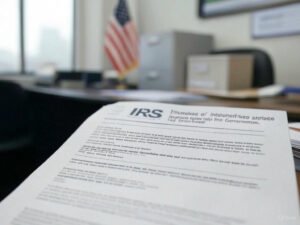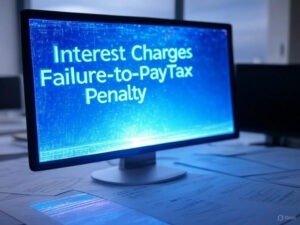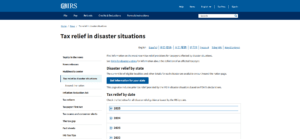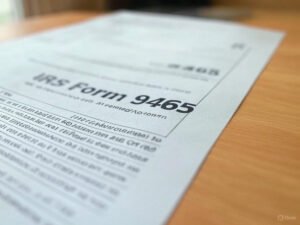IRS Penalties for Filing Taxes Late in 2025: Here’s What You Should Understand
Whether we like it or not, we must file our taxes within the given period. Sometimes, though, life gets in the way, and we miss deadlines. If you didn’t file your federal income tax return by April 15, 2025, the IRS (Internal Revenue Service) may impose penalties and interest. This article breaks down the IRS late tax filing penalties for 2025 in simple language, explaining what they are, how they’re calculated, and how you can avoid or reduce them.

Why Filing Taxes on Time Matters
The IRS sets a firm deadline for filing federal income tax returns, typically April 15. For 2025, this deadline applies unless you live in an area affected by a natural disaster or other IRS relief. Filing late without an extension can have serious consequences, especially if you owe taxes. Missing the deadline can significantly increase your tax bill, so staying on schedule is always best.

Key Consequences of Filing Late
There are two main penalties you might face for late tax filing or payment:
- Failure-to-File Penalty: This applies if you don’t submit your tax return by the due date or extended deadline.
- Failure-to-Pay Penalty: This is charged if you don’t pay the taxes you owe by the deadline, even if you filed on time or received an extension.
In addition to these penalties, the IRS adds interest to unpaid taxes, which can make your bill grow quickly over time.
Failure-to-File Penalty
The failure-to-file penalty is charged when you don’t submit your tax return by the deadline. This penalty is one of the heftiest, designed to encourage taxpayers to file their returns on time.

How It’s Calculated
- Rate: 5% of the unpaid taxes for each month (or part of a month) your return is late, up to a maximum of 25%.
- Minimum Penalty: If your return is more than 60 days late, the minimum penalty is the lesser of $525 or 100% of the unpaid taxes for 2025 returns.
- Combined Penalties: If both the failure-to-file and failure-to-pay penalties apply in the same month, the failure-to-file penalty is reduced to 4.5% to keep the combined rate at 5%.
Example
Suppose you owe $5,000 in taxes and file your return two months late without requesting an extension:
- Penalty = $5,000 × 5% × 2 months = $500
The failure-to-pay penalty (explained below) will apply if you also haven’t paid the taxes. If your return is over 60 days late, you’ll face a minimum penalty of $525 (or 100% of the tax owed, if less).
Failure-to-Pay Penalty
Even if you file on time or get an extension, you must pay your taxes by April 15, 2025, to avoid the failure-to-pay penalty. An extension to file does not extend the payment deadline.

How It’s Calculated
- Rate: 0.5% per month (or part of a month) of the unpaid taxes, up to a maximum of 25%.
- Reduced Rate: If you set up an IRS payment plan, the penalty drops to 0.25% per month while the plan is active.
- Increased Rate: If you don’t pay within 10 days of receiving an IRS notice of intent to seize property, the monthly penalty rises to 1%.
Example
If you owe $5,000 and don’t pay for three months:
- Penalty = $5,000 × 0.5% × 3 months = $75
If you set up a payment plan, the penalty would be:
- $5,000 × 0.25% × 3 months = $37.50
Interest Charges
The IRS charges interest on unpaid taxes and penalties. Interest starts accruing the day after the tax deadline (April 16, 2025) and compounds daily until you pay the full amount.

How It’s Calculated
- Rate: The interest rate is the federal short-term rate plus 3%, adjusted quarterly. For early 2025, this is approximately 7% per year, compounded daily.
- No Waiver: Interest cannot be waived unless the related penalty is removed.
Example
If you owe $5,000 and don’t pay for 30 days at a 7% annual rate:
- Daily interest rate ≈ 7% ÷ 365 ≈ 0.0192%
- Interest for 30 days = $5,000 × 0.0192% × 30 ≈ $28.80
Maximum Penalties
The combined failure-to-file and failure-to-pay penalties are capped at 47.5% of the unpaid taxes:
- Failure-to-File: Up to 22.5% (after 5 months, adjusted for combined penalties).
- Failure-to-Pay: Up to 25%.
With interest added, late filing and payment can become very expensive.
Special Cases
Disaster Relief Extensions
Suppose you live in an area affected by a FEMA-declared disaster in 2024 (e.g., parts of Alabama, Florida, Georgia, North Carolina, South Carolina, or Los Angeles County, California). In that case, you may qualify for an automatic extension to file and pay until May 1, 2025, or later (e.g., October 15, 2025, for California wildfire victims). Check the IRS Disaster Relief page for details.

Military Personnel
Military members serving in combat zones or outside the U.S. are automatically granted a 180-day extension to file and pay without penalties.

U.S. Citizens Living Abroad
U.S. citizens living and working abroad receive an automatic extension to file until June 15, 2025. However, taxes must still be paid by April 15, 2025, to avoid penalties.
How to Avoid or Minimize Penalties
Here are practical steps to avoid or reduce penalties:
File on Time
- File by April 15, 2025, using IRS Free File, tax software, or a tax professional.
- Request an extension to October 15, 2025, using Form 4868, filed by April 15. Pay any estimated taxes to avoid the failure-to-pay penalty.
- Tools like TurboTax Easy Extension can simplify the extension process.

Pay What You Can
- Pay even a portion of your taxes by April 15, 2025, to reduce penalties and interest.
- Use IRS Direct Pay, debit/credit cards, or electronic payments via irs.gov.
Set Up a Payment Plan
- The IRS offers payment plans to spread out your tax debt, reducing the failure-to-pay penalty to 0.25% per month.
- Apply using Form 9465 or the IRS website.

Request Penalty Relief
- First-Time Penalty Abatement: If you’ve filed and paid on time for the past three years, you may qualify for a one-time penalty waiver. Call the IRS at 800-829-1040 or write to request.
- Reasonable Cause: Penalties may be waived for valid reasons like illness or natural disasters. Submit a written explanation with supporting documents.
- Dispute Penalties: If you believe a penalty was applied in error, contact the IRS using the number on your notice or write to the address provided.
Don’t Miss Refunds
Even if you’re due a refund, file within three years to claim it, or the money goes to the Treasury. Refunds don’t incur penalties for late filing.

Tips to Stay on Track
- Use Electronic Filing: E-filing is faster and reduces errors. Options like IRS Free File or TurboTax are available.
- Monitor IRS Notices: Respond quickly to IRS letters to address issues or request relief.
- Check Disaster Relief: If you’re in an affected area, confirm your eligibility for extended deadlines.
What Happens If You Ignore Penalties?
Ignoring penalties can lead to serious consequences:
- Growing Debt: Penalties and interest will increase your tax bill.
- IRS Collection Actions: The IRS can issue a levy (garnish wages or bank accounts) or place a lien on your property.
- Passport Issues: If you owe over $65,000 in 2025, the IRS may request the State Department restrict or revoke your passport.
- Legal Consequences: In rare cases, tax evasion can lead to fines or jail time.
Conclusion
Missing the April 15, 2025, tax filing deadline can lead to costly penalties, but there are ways to minimize the damage. File on time, pay what you can, or request an extension with estimated payments. If penalties are applied, explore relief options like first-time abatement or reasonable cause. By staying proactive and informed, you can manage your tax obligations and avoid unnecessary costs.
For personalized advice, consult a tax professional or visit IRS.gov. If you’re in a disaster-affected area, check the IRS website for relief options.
Discover how AI is transforming design in CAD processes.
Explore the fusion of nanotechnology and AI for innovative tech advancements.
Learn about AI’s role in revolutionary technology in the UAE.
See how AI is shaping next-gen wearables like AR glasses.
Check out the influence of AI in the development of artificial intelligence.


















Post Comment